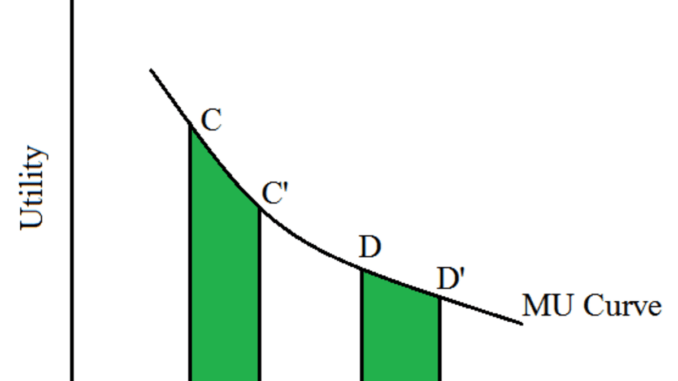
The British economist Alfred Marshall believed that the more of something you have, the less of it you want. This phenomenon is referred to as diminishing marginal utility by economists. Diminishing marginal utility refers to the phenomenon that each additional unit of gain leads to an ever-smaller increase in subjective value. For example, three bites of candy are better than two bites, but the twentieth bite does not add much to the experience beyond the nineteenth (and could even make it worse). This effect is so well established that it is referred to as the "law of diminishing marginal utility" in economics (Gossen, 1854/1983), and is reflected in the concave shape of most subjective utility functions. This refers to the increase in utility an individual gains from increasing their consumption of a particular good. "The law of diminishing marginal utility is at the heart of the explanation of numerous economic phenomena, including time preference and the value of goods … The law says, first, that the marginal utility of each homogeneous unit decreases as the supply of units increases (and vice versa); second, that the marginal utility of a larger-sized unit is greater than the marginal utility of a smaller-sized unit (and vice versa). The first law denotes the law of diminishing marginal utility; the second law denotes the law of increasing total utility."
英国经济学家阿尔弗雷德-马歇尔认为,你拥有的东西越多,你想要的东西就越少。这种现象被经济学家称为边际效用递减。边际效用递减指的是这样一种现象:每增加一个单位的收益,主观价值的增加就会越来越小。例如,吃三口糖果比吃两口好,但第二十口糖果对第十九口糖果以外的体验没有增加多少(甚至可能使它变得更糟)。这种效应是如此的成熟,以至于它在经济学中被称为 "边际效用递减法则"(Gossen, 1854/1983),并反映在大多数主观效用函数的凹形上。这指的是个人从增加对某一特定物品的消费中获得的效用增加。"边际效用递减规律是解释众多经济现象的核心,包括时间偏好和商品价值……。该定律说,首先,每个同质单位的边际效用随着单位供应的增加而减少(反之亦然);其次,较大尺寸单位的边际效用大于较小尺寸单位的边际效用(反之亦然)。
一般而言,消费者偏好某物而未能获得,或拥有数量不够大时,增加消费量则其满足感大增(边际效用增加);但拥有数量足够时,再增加消费量则其满足感增加幅度逐渐平缓(边际效用递减);拥有数量太多时,再增加消费量则反而感觉厌恶(边际效用减为负且继续递减,累积之总效用因此,亦减少)。在正常状况下,消费者拥有足够数量而边际效用递减后,会将有限资源配置转移以满足其他欲望,不至于消费同一商品过量到感觉厌恶。
原因是:随着可变要素投入量的增加,可变要素投入量与固定要素投入量之间的比例在发生变化。在可变要素投入量增加的最初阶段,相对于固定要素来说,可变要素投入过少,因此,随着可变要素投入量的增加,其边际产量递增,当可变要素与固定要素的配合比例恰当时,边际产量达到最大。如果再继续增加可变要素投入量,由于其他要素的数量是固定的,可变要素就相对过多,于是边际产量就必然递减。
实际应用:
比如快期末考试了,你一门学科能考95分,一门只能考59分,那把精力用在95那门最后也许能得到97,但是把精力用在59那门,或许能得70分。
本站没有存储任何书籍、杂志和报纸。
页面内容只做展示和推荐。如果您喜欢本期内容请购买正版。
This site does not store any books, magazines or newspapers.
The contents of the pages are for display and recommendation only.
If you like the content of this issue please purchase the original.